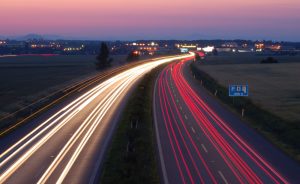Hello Darkness My Old Friend
While Sound of Silence was recorded 55 years ago, early darkness comes to Southwest Florida every autumn. 
By the time Daylight Savings Time begins November 4, we will all be dealing with dusk or darkness during our evening commute. Love it or hate it, early darkness will be with us again until spring.
A report published by the National Institutes of Health found an increased risk of car accidents immediately after the autumn shift in Daylight Savings Time. However, it also found a similar increased risk with the spring shift (which provides more light later in the day.) Researchers believe it likely that the time-shift’s impact on sleeping patterns is likely responsible for making the roads more dangerous.
But it is the autumn shift that leaves us with six months of early darkness. And statistics continue to show that darkness increases accident risks, relative to the number of people on the roads.
Night Driving Safety for Motorists
Some motorists just don’t drive well at night. Whether because they don’t do it often, or because they are genetically predisposed to problems with vision and depth perception after dark, the increased risks of driving at night are real. Our veteran injury lawyers in Naples and Fort Myers encourage all motorists to take steps to improve their road safety.
Popular Mechanics is already one step ahead, having published in late September tips for drivers to own the night through safer night-driving skills.
- Headlights: Make sure your headlights are aimed correctly and in proper working order. It is easy to outrun your headlights, even if they are in good condition. Low-beams typically shine 160 to 250 feet ahead; it takes a driver traveling at 60 mph more than 200 feet to come to a stop.
- Dim interior lights: Utilize this trick known to pilots. Interior lighting significantly degrades night vision. Perhaps you’ve been going down the road at night and someone turned on the dome light for a moment. You may have been surprised at how hard it was to see when the light went back out. Ambient interior lighting has a subtler but nevertheless significant impact on your ability to see at night.
- Use proper eyewear: Biologically, none of us can see as well at night. This makes proper eyewear even more critical.
- Don’t stare at oncoming lights: Like interior lights, lights outside the vehicle, whether from an oncoming vehicle or businesses or parking lots. can degrade night vision.
Night Safety for Bicyclists and Pedestrians
Riders and walkers are at highest risk after dark. Intoxication is a significant factor in causation. Both walkers and riders are well served by wearing bright colored/reflective clothing. Walkers should always use sidewalks whenever possible and walk facing traffic. Riders should ride in the same direction as traffic and make sure their lights and reflectors are in proper working order. Florida Statute 316.2065 bike regulations governs the use of lights and reflectors, as well as helmets for riders under the age of 16.
Taking steps to improve your safety after dark means being a conscientious driver, rider and walker as we head into the busy holiday and tourist season.
If you or a loved one is injured, call Associates and Bruce L. Scheiner, Attorneys for the Injured, at 1-800-646-1210.
 Florida Injury Lawyer Blog
Florida Injury Lawyer Blog





